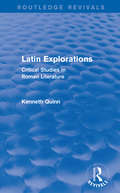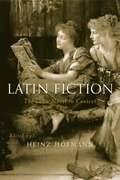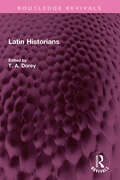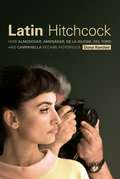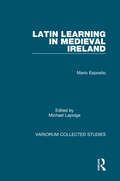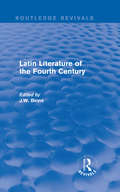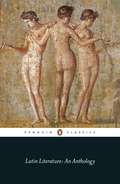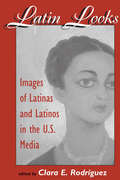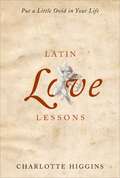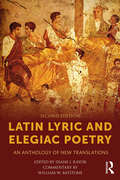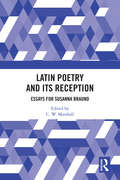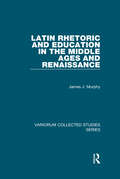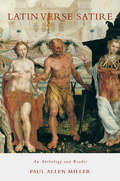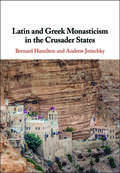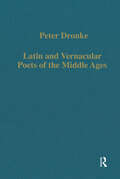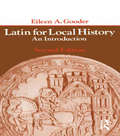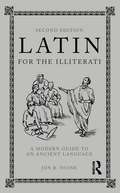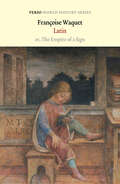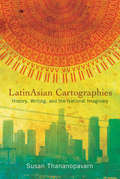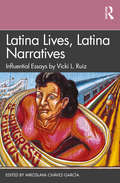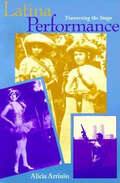- Table View
- List View
Latin Explorations: Critical Studies in Roman Literature (Routledge Revivals)
by Kenneth QuinnLatin Explorations, first published in 1963, offers a fresh approach to Roman poetry from Catullus to Ovid. Traditionally, the period is divided for specialist studies – Lyric, Epic and Elegy. In each of them, techniques of interpretation prevail, isolated from contemporary ideas about poetry and dominated by barriers between ‘textual’, ‘exegetical’ and ‘aesthetic’ criticism. Kenneth Quinn discerns in Roman poetry of this period the adolescence, maturity and decay of a single coherent tradition whose internal unity surpasses differences of form. His argument attempts to reverse the dissociation of purely academic research from appreciative criticism, whilst also incorporating the work of textual scholars. Each chapter is supported by a detailed analysis of the texts: nearly 700 lines of poetry are discussed and translated. Latin Explorations will be of significant value not only to students of the Classics, but also to the ‘Latinless’ general reader who is interested in Roman literature.
Latin Fiction: The Latin Novel In Context
by Heinz HofmannLatin Fiction provides a chronological study of the Roman novel from the Classical period to the Middle Ages, exploring the development of the novel and the continuity of Latin culture. Essays by eminent and international contributors discuss texts including: * Petronius, Satyrica and Cena Trimalchionis* Apuleius, Metamorphose(The Golden Ass) and The Tale of Cupid and Psyche* The History of Apollonius of Tyre* The Trojan tales of Dares Phrygius and Dictys Cretensis* The Latin Alexander* Hagiographic fiction* Medieval interpretations of Cupid and Pysche, Apollonius of Tyre and the Alexander Romance. For any student or scholar of Latin fiction, or literary history, this will definitely be a book to add to your reading list.
Latin Historians (Routledge Revivals)
by T. A. DoreyFirst published in 1966, Latin Historians gives an account of some of the most important Latin historians. There are chapters on Caesar, Sallust, Livy and Ammianus Marcellinus, together with an account of earlier historians, and on Polybius, the Greek who had much influence on the Roman World. Bede, the earliest of the great Christian historians in England, is also discussed. This book will be of interest to students of history, literature and classical studies.
Latin Hitchcock: How Almodóvar, Amenábar, De la Iglesia, Del Toro and Campanella Became Notorious
by Dona KercherThis study explores how five major Spanish and Latino directors modeled their early careers on Hitchcock and his film aesthetics.
Latin Hitchcock: How Almodóvar, Amenábar, De la Iglesia, Del Toro, and Campanella Became Notorious
by Dona KercherThis study explores how five major directors—Pedro Almodóvar, Alejandro Amenábar, Alex de la Iglesia, Guillermo del Toro, and Juan José Campanella—modeled their early careers on Hitchcock and his film aesthetics. In shadowing Hitchcock, their works embraced the global aspirations his movies epitomize. Each section of the book begins with an extensive study, based on newspaper accounts, of the original reception of Hitchcock's movies in either Spain or Latin America and how local preferences for genre, glamour, moral issues, and humor affected their success. The text brings a new approach to world film history, showcasing both the commercial and artistic importance of Hitchcock in Spain and Latin America
Latin Journey: Cuban and Mexican Immigrants in the United States
by Alejandro Portes Robert L. BachLatin Journey details an eight-year study of Mexican and Cuban immigrants to the U.S.
Latin Learning in Medieval Ireland (Variorum Collected Studies)
by Michael Lapidge Mario EspositoThe field of Hiberno-Latin literature, a term coined to describe the Latin literature written in Ireland, or by Irishmen abroad, between 400 and 1500, was first defined by the late Mario Esposito. His work, too, revealed its vast extent and range, so enabling a significantly better understanding of the importance of Irish scholarship in the cultural history of the Western Middle Ages. This volume concentrates on Hiberno-Latin authors, and on texts composed in Ireland; a second collection of Esposito’s articles contains studies on Irish learning and texts written on the Continent. The great strength of his research is that it is founded on unparalleled knowledge of the manuscripts - many of which, indeed, no longer survive. The articles, now provided with extensive indexes to facilitate their consultation, therefore form the essential basis and guide for any further enquiry into the authors dealt with or their works.
Latin Letters in Early Christian Ireland (Variorum Collected Studies)
by Michael W. HerrenThis book is concerned with the transmission and reception of Latin literary culture in the early Middle Ages, and with the production of Latin works in Ireland and in Irish centres on the Continent. In these articles, Professor Herren deals with several closely related themes: the introduction of Latin into Ireland and the study of Latin literary heritage; the language and metre of Hiberno-Latin writings; and questions of dating and authorship pertaining to a number of crucial texts, from Columbanus to John Scottus Eriugena.
Latin Literature of the Fourth Century (Routledge Revivals)
by J. W. BinnsThis volume, offering an insight into the literary world of Rome in the fourth century AD, reflects an increased interest in the writers of the 150 years before the collapse of the Western Empire, who have long been over-shadowed by the pre-eminence accorded since the eighteenth century to the Golden and Silver ages. Among the writers examined are Ausonius, the poet, Imperial official and tutor to Gratian; Claudian, the last major ‘classical’ poet; Prudentius, and Paulinus of Nola, two of the founders of Christian Latin poetry; Symmachus, the letter writer and supporter of die-hard paganism; and St. Augustine, whose influence on Christian thought and the Middle Ages is incalculable. These essays consider how such writers responded to a world where vitality was ebbing from the old forms of political life, religion and literature, giving way to new institutions, modes of life and horizons of reflection.
Latin Literature: An Anthology
by Michael GrantA classic introduction to Latin literature, with translations of the best passages from Virgil, Livy, Ovid, Seneca and many others.This classic anthology traces the development of Latin literature from the early Republican works of Cicero and Catullus, to the writers of the Empire such as Lucan and Petronius, to the later writings of St Augustine. The selections cover comedy and epic, history and philosophy, in prose and in verse, and each passage is prefaced by an introduction to the author and his influence. The translators range across history from Alexander Pope and Lord Byron to contemporaries. The result is a broad and brilliant overview of the civilization of Rome and its Empire - an ideal introduction to Latin literature.Michael Grant was born in 1914. He served as an intelligence officer during the Second World War, and subsequently held academic posts at the universities of Cambridge, Edinburgh, Khartoum and Belfast. Over his lifetime, he published nearly fifty books on the ancient world, ranging from studies of Roman coinage, to biographies of Caesar, Nero and Jesus, to books on Ancient Israel and the Middle Ages. Many of his translations were published in Penguin Classics. Professor Grant moved to Italy in 1966, where he spent most of the rest of his life until his death in 2004.
Latin Looks: Images of Latinas and Latinos in the U.S. Media
by Clara E RodriguezWhat are “Latin looks”? A Latin look may seem at first blush to be something that everyone recognizes—brunette, sensual, expressive, animated, perhaps threatening. But upon reflection, we realize that these are the images that are prevalent in the media, while the reality in Latino communities is of a rich diversity of people and images. This book brings together a selection of the best, the most interesting, and the most analytically sophisticated writing on how Latinos have been portrayed in movies, television, and other media since the early years of the twentieth century and how images have changed over time in response to social and political change. Particular emphasis is given to representations of class, gender, color, race, and the political relationship between the United States and Latin America. Together the essays offer a corrective lens for interpreting how images are created, perpetuated, and manipulated.
Latin Love Lessons: Put a Little Ovid in Your Life
by Charlotte HigginsIt wasn't just heated floors, hot baths, aqueducts, and paved roads that the Romans did first and best—they were also experts at the art of love. From the most effective pickup lines to percipient advice on getting over a breakup, from grooming tips to sex tips, the Romans had time-proof solutions. Charlotte Higgins brings them together in this indispensable guide to love—a collection of the richest, most illuminating, and sensuous writing about this mysterious emotion that can move us to joy or despair.Filled with the sage advice of Catullus, Virgil, Horace, Ovid, Propertius, and Tibullus, this witty, smart, and laugh-out-loud-funny handbook offers a fresh, new take on romance based on some of civilization's oldest adages.
Latin Lyric and Elegiac Poetry: An Anthology of New Translations (Reference Library Of The Humanities #Vol. 1425)
by Diane J. Rayor William W. BatstoneLatin Lyric and Elegiac Poetry, first published almost 25 years ago, offered students accurate and poetic translations of poems from the sudden flowering of lyric and elegy in Rome at the end of the Republic and in the first decades of the Augustan principate. Now updated in this second edition, the volume has been re-edited with both revised and new translations and an updated commentary and bibliography for readers in a new century, ensuring that this much-valued anthology remains useful and relevant to a new generation of students studying ancient literature and western civilization. The volume features an expanded selection of newly translated poetry including: fresh Catullus translations, with a greater selection including Poem 64 fresh Sulpicia translations and the five poems of the "Garland of Sulpicia" six new Propertius poems new and revised selections from Tibullus, Ovid and Horace. The second edition reflects changing interests and modes of reading while remaining true to the power of the poetry that has influenced the literature of many cultures. The combination of accurate and vibrant translations with thorough commentary makes this an invaluable anthology for those interested in poetry, world literature, Roman civilization, and the history of ideas and sexuality, allowing readers to compare different poets' responses to politics, love and sex, literary innovation, self, and society.
Latin Poetry and Its Reception: Essays for Susanna Braund (Routledge Monographs in Classical Studies)
by C. W. MarshallThis volume offers 18 new studies reflecting the latest scholarship on Latin verse, explored both in its original context and in subsequent contexts as it has been translated and re-imagined. All chapters reflect the wide research interests of Professor Susanna Braund, to whom the volume is dedicated. Latin Poetry and Its Reception assembles a blend of senior scholars and new voices in Latin literary studies. It makes important contributions to the understanding of Kingship in Hellenistic and Roman thought, with the first four chapters dedicated to exploring this theme in Republican poetry, Virgil, Seneca, and Statius. Chapters focusing on the modern reception include case studies from the 16th to the 21st century, with discussions on Gavin Douglas, Edward Gibbon, Herman Melville, Igor Stravinsky, and Elena Ferrante, among others. No comparable volume provides a similar range. Latin Poetry and Its Reception will appeal to all scholars of Latin poetry and classical reception, from senior undergraduates to scholars in Classics and other disciplines.
Latin Rhetoric and Education in the Middle Ages and Renaissance (Variorum Collected Studies #827)
by James J. MurphyThe essays in this volume deal with the history of rhetoric and education for the thousand years from the early Middle Ages to the European Renaissance. They represent the author's pioneering efforts over four decades to piece together a kind of mosaic which will provide elements necessary to construct a history of that thousand years of language activity. Some essays deal with individual writers like Giles of Rome, Peter Ramus, Gulielmus Traversanus, or Antonio Nebrija, some focus on the influence of Cicero and Quintilian and other ancient sources. The essays dealing specifically with education open up different inquiries into the ways language use was promoted, and by whom. Others explore the relations between Latin rhetoric and medieval English literature and, finally, several deal with the impact of printing, a subject still not completely understood.
Latin Verse Satire: An Anthology and Reader
by Paul Allen MillerA wide variety of texts by the Latin satirists are presented here in a fully loaded resource to provide an innovative reading of satire's relation to Roman ideology. Brimming with notes, commentaries, essays and texts in translation, this book succeeds in its mission to help the student understand the history of Latin's modern scholarly reception.Focusing on the linguistic difficulties and problems of usage, and examining aspects of meter and style necessary for poetry appreciation, the commentary places each selection in its own historical context then using essays and critical excerpt, the genre's most salient features are elucidated to provide a further understanding of its place in history.Extremely student friendly, this stands well both as a companion to Latin Erotic Elegy and in its own right as an invaluable fund of knowledge for any Latin literature scholar.
Latin and Greek Monasticism in the Crusader States
by Andrew Jotischky Bernard HamiltonMonasticism was the dominant form of religious life both in the medieval West and in the Byzantine world. Latin and Greek Monasticism in the Crusader States explores the parallel histories of monasticism in western and Byzantine traditions in the Near East in the period c.1050-1300. Bernard Hamilton and Andrew Jotischky follow the parallel histories of new Latin foundations alongside the survival and revival of Greek Orthodox monastic life under Crusader rule. Examining the involvement of monasteries in the newly founded Crusader States, the institutional organization of monasteries, the role of monastic life in shaping expressions of piety, and the literary and cultural products of monasteries, this meticulously researched survey will facilitate a new understanding of indigenous religious institutions and culture in the Crusader states.
Latin and Vernacular Poets of the Middle Ages (Variorum Collected Studies)
by Peter DronkeThis volume presents a series of penetrating analyses of particular poems and problems of literary history illustrating the many sides of medieval poetry and the interactions of learned, popular and courtly traditions. The first and longest essay, 'Waltharius-Gaiferos', aims to characterize the diverse treatments of one of the major European heroic themes - in modes that include lay and epic, saga and ballad, and range from pre-Carolingian times to the Renaissance. There follow three interrelated essays on the medieval transformations of Ovid, and a larger group devoted to close reading of medieval lyrics. After discussing some brilliant Latin compositions, of the 9th-12th centuries, both sacred and profane, and the work of two of the most captivating 'goliard' poets, Peter Dronke looks at the earliest formations of love-lyric in two vernaculars, Spanish and English. Finally, he explores the unique symbiosis of Latin and vernacular imagery in two key moments of Dante's Divine Comedy. Ce volume contient une série d’analyses perspicaces de poèmes spécifiques et de certains problèmes de l’histoire littéraire illustrant les multiples facettes de la poésie médiévale et l’interaction des traditions érudites, populaires et courtoises. Le premier essai, "Waltharius-Gaïferos", tente de décrire les divers traitements de l’un des principaux thèmes héroïques européens selon des modes qui incluent: le lai et l’épique, la saga et la ballade et qui s’étendent sur une période allant de l’époque pré-carolingienne à la Renaissance. Suivent trois articles corrélatifs sur les adaptations médiévales des textes d’Ovide, ainsi qu’un groupe d’études voue à la lecture détaillée de la poésie lyrique médiévale. Après avoir considéré l’oeuvre de deux des plus passionnants poètes "goliards" et un certain nombre de remarquables compositions latines, sacrées et profanes, datant du 9e-12e siècles, Peter Dronke se tourne vers les pre
Latin for Local History: An Introduction
by Eileen A. GooderLatin for Local History provides a self-teaching guide for those historians who wish to tackle the language in which the majority of pre-eighteenth century historical records have been written. It is unique in dealing only with Latin found in historical records of the medieval period. Practice material and exercises are provided in the form of documents most commonly encountered by the historian in their research - deeds, charters, court rolls, accounts, bishops' registers and so on.
Latin for the Illiterati: A Modern Guide to an Ancient Language
by Jon R. StoneThis revised and updated edition includes a brand new foreword by Richard LaFleur and more than fifteen hundred new entries and abbreviations. Organized alphabetically within the categories of verba (common words and expressions), dicta (common phrases and familiar sayings), and abbreviations, this practical and helpful reference guide is a comprehensive compendium of more than 7,000 Latin words, expressions, phrases, and sayings taken from the world of art, music, law, philosophy, theology, medicine and the theatre, as well as witty remarks and sage advice from ancient writers such as Virgil, Ovid, Cicero, and more.
Latin: or, the Empire of a Sign (Verso World History Series)
by Françoise WaquetA highly original and accessible history of Latin between the sixteenth and twentieth centuriesFor almost three centuries, Latin dominated the civic and sacred worlds of Europe and, arguably, the entire western world. From the moment in the sixteenth century when it was adopted by the Humanists as the official language for schools and by the Catholic Church as the common liturgical language, it was the way in which millions of children were taught, people prayed to God, and scholars were educated.Francoise Waquet&’s history of Latin between the sixteenth and twentieth centuries is a highly original and accessible exploration of the institutional contexts in which the language was adopted.It goes on to consider what this conferring of power and influence on Latin meant in practice. Among the questions Waquet investigates are: What privileges were, and are still, accorded to those who claim to have studied Latin? Can Latin as a subject for study be anything more than purely linguistic or does it reveal a far more complex heritage? Has Latin&’s deeply embedded cultural legacy already given way to a nostalgic exoticism?Latin: A Symbol&’s Empire is a valuable work of reference, but also an important piece of cultural history: the story of a language that became a symbol with its own, highly significant empire.
LatinAsian Cartographies: History, Writing, and the National Imaginary (Latinidad: Transnational Cultures in the United States)
by Susan ThananopavarnLatinAsian Cartographies examines how Latina/o and Asian American writers provide important counter-narratives to the stories of racial encroachment that have come to characterize twenty-first century dominant discourses on race. Susan Thananopavarn contends that the Asian American and Latina/o presence in the United States, although often considered marginal in discourses of American history and nationhood, is in fact crucial to understanding how national identity has been constructed historically and continues to be constructed in the present day. Thananopavarn creates a new “LatinAsian” view of the United States that emphasizes previously suppressed aspects of national history, including imperialism, domestic racism during World War II, Cold War operations in Latin America and Asia, and the politics of borders in an age of globalization. LatinAsian Cartographies ultimately reimagines national narratives in a way that transforms dominant ideas of what it means to be American.
Latina Lives, Latina Narratives: Influential Essays by Vicki L. Ruiz
by Miroslava Chávez-GarcíaThis book brings together the most influential and widely known writings of Vicki L. Ruiz, a leading voice in the fields of Chicana/o, Latina/o, women’s, and labor history. For nearly forty years, Ruiz has produced scholarship that has provided the foundation for a rich and nuanced understanding of the ways in which Chicanas and Latinas negotiate the structures impinging on their everyday lives. From challenging familial, patriarchal cultural norms, building interethnic social networks in the neighborhood and workplace, and organizing labor unions, to fighting gender and racial discrimination in the courts, at work, in the schools, and on the streets, Ruiz’s studies have examined the countless struggles, roadblocks, and victories Chicanas and Latinas have faced in the twentieth century and beyond. The articles in this book are organized chronologically to reflect the evolution of Ruiz’s intellectual contributions as well as her commitment to integrating feminist history, theory, and methodology, and show how she has generously offered insights, reflections, and humor in helping us define and shape who we are as mujeres, Chicanas, Latinas, scholars, teachers, and mentors. With its narrative flow and engaging prose, Ruiz’s scholarship connects with academic and public audiences and this collection fulfills a much-needed demand in the teaching of women’s, Chicana/o, Latina/o, and labor history.
Latina Performance: Traversing the Stage
by Alicia ArrizónA study exploring the role of Latina women in theater performance, literature, and criticism.Arrizón’s examination of Latina performance spans the twentieth century, beginning with oral traditions of corrido and revistas. She examines the soldadera and later theatrical personalities such as La Chata Noloesca and contemporary performance artist Carmelita Tropicana.Latina Performance considers the emergence of Latina aesthetics developed in the United States, but simultaneously linked with Latin America. As dramatists, performance artists, protagonists, and/or cultural critics, the women Arrizón examines in this book draw attention to their own divided position. They are neither Latin American nor Anglo, neither third- or first-world; they are feminists, but not quite “American style.” This in-between-ness is precisely what has created Latina performance and performance studies, and has made “Latina” an allegory for dual national and artistic identities.“Alicia Arrizón’s Latina Performance is a truly innovative and important contribution to Latino Studies as well as to theater and performance studies.” —Diana Taylor, New York University“Arrizón’s . . . important book revolves around the complex issues of identity formation and power relations for US women performers of Latin American descent. . . . Valuable for anyone interested in theater history and criticism, cultural studies, gender studies, and ethnic studies with attention to Mexican American, Chicana/o, and Latina/o studies. Upper—division undergraduates through professionals.” —E. C. Ramirez, Choice
